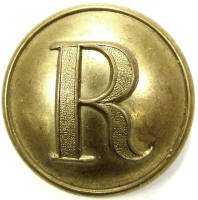
A virtual examination of artifacts of the American Civil War
by Harry Ridgeway
 |
Ridgeway Civil War Research Center, A virtual examination of artifacts of the American Civil War |
| Civil War Artillery | |
by Harry Ridgeway |
| Artillery projectile, stand of grape, contained by rings and plates, iron balls, no sabot, 32 pounder, or rifle 6.4in. The stand of grape was the artillerist's weapon of last resort. Once the enemy got close to the battery, the gunners would load these rounds, and the flimsy stand would burst on firing sending the contents in scatter fashion against the troops charging the cannon. The fire was devastating against the troops but the enemy would be so close that options to reload and shoot would have been limited. The stand of grape consisted of top and bottom plates, held together with a bolt and nut, three rows of three balls (9 total) were stacked around the post, and held in place with two rings and the bolt. The bolt is held in place by a threaded nut on the top, bottom is loosely fitted into a slightly irregular hole on the bottom plate. Based on the diameter of this projectile, it is believed that this could be used with any 6.4in. cannon, smoothbore 32 pounder, rifled 32 pounder or the Confederate Brook rifle. Projectile measures: diameter 6.2 in., length 8 in., weight 40 lbs. Individual balls will measure 2.875in. approximately, the balls are often irregular. Research Center: Artillery2652-GrapeStand, Ref: Bell, Heavy Ordnance, pg. 105. Details click: http://relicman.com/artillery/Artillery2652-GrapeStand.html. |
| Ridgeway Civil War Research Center, A virtual examination of artifacts of the American Civil War. Artillery Research center, artillery, click: http://relicman.com/artillery/Artillery0000-Index.html. Research center, artillery, click: http://relicman.com/artillery/Artillery0000-Index.html. |
| Civil War Relicman, Harry Ridgeway, Civil War artillery, Relicman sales catalog. Click here: http://relicman.com/artillery/RelicmanSalesArtillery1.html. Artillery for sale: http://relicman.com/artillery/RelicmanSalesArtillery1.html. |